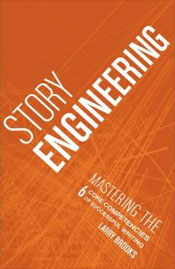Story Engineering by Larry Brooks
Like many aspiring novelists, I tend to collect “how to write” books. I think I have about a dozen on my bookshelf and have read another twenty from the library. All have been useful, inspiring, and informative in their own right, but only a chosen few have made it to my “must have” status. Story Engineering by Larry Brooks is one of them. Larry doesn’t seek to inspire (though he does). He doesn’t tell (or show) you to “show don’t tell.” He doesn’t tell you how to get an agent.
What he does tell you is priceless and long overdue: He tells you how to construct a story. Simple, yes? But most new writers, myself included, missed it. Despite the insistence that fiction writing is 100% art, there are established standards in which a well-told story will flow. Even the SOP, or seat-of-the-pants writers who get published follow these standards, they just have naturally honed instincts that get them to the destination without an outline. The average keytapper like me, however, does not have finally honed instincts. And, unless your initials are Stephen King, chances are you don’t either.
Here’s the basics:
- Each novel is broken up into 4 sections (or “acts”)–Setup, Response, Attack, and Resolution. From the character perspective Larry describes these sections as Orphan, Wanderer, Warrior, and Martyr.
- There are essential plot points between these acts: First Plot Point (the protagonist is launched into his journey) at the end of scene one. Midpoint at…well, the middle. and the Second Plot Point, just before the climactic Act 4.
- Interspersed in these sections are “Pinch Points,” where the antagonist makes himself known to our hero.
